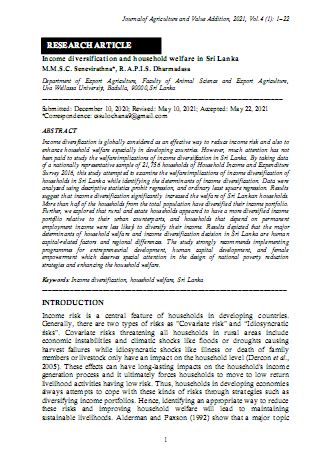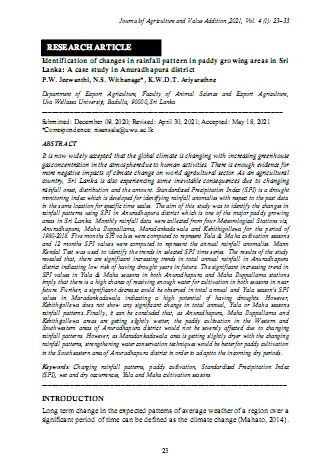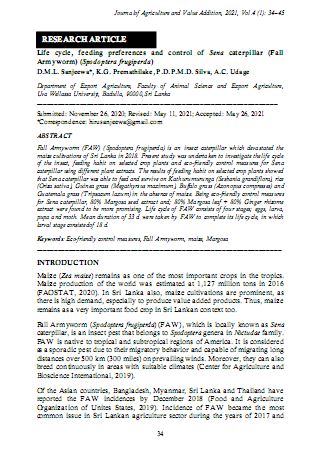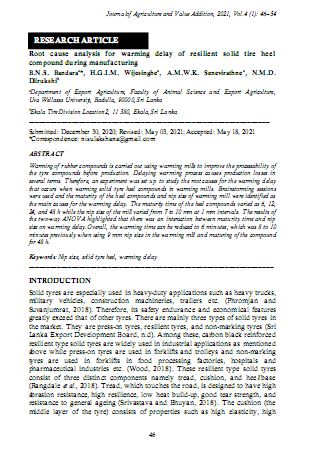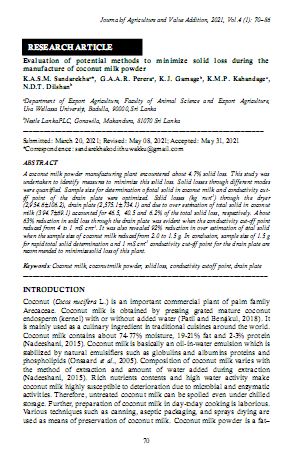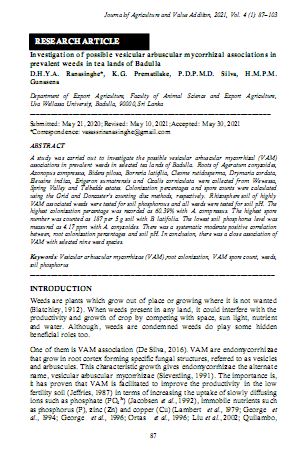
Volume 04 Issue 01
RESEARCH ARTICLES
01. Income diversification and household welfare in Sri Lanka
M.M.S.C. Senevirathna*, R.A.P.I.S. Dharmadasa
Department of Export Agriculture, Faculty of Animal Science and Export Agriculture, Uva Wellassa University, Badulla, 90000 , Sri Lanka
INFORMATION
Journal Title: Journal of Agriculture and Value Addition
Volume : 4 Issue 01
Page : 1- 22
Submitted: December 10, 2020; Revised: May 10, 2021; Accepted: May 22, 202
* Correspondence: cssulochana9@gmail.com
ABSTRACT
Income diversification is globally considered as an effective way to reduce income risk and also to enhance household welfare especially in developing countries. However, much attention has not been paid to study the welfare implications of income diversification in Sri Lanka. By taking data of a nationally representative sample of 21,756 households of Household Income and Expenditure Survey 2016, this study attempted to examine the welfare implications of income diversification of households in Sri Lanka while identifying the determinants of income diversification. Data were analyzed using descriptive statistics, probit regression, and ordinary least square regression. Results suggest that income diversification significantly increased the welfare of Sri Lankan households. More than half of the households from the total population have diversified their income portfolio. Further, we explored that rural and estate households appeared to have a more diversified income portfolio relative to their urban counterparts, and households that depend on permanent employment income were less likely to diversify their income. Results depicted that the major determinants of household welfare and income diversification decision in Sri Lanka are human capital-related factors and regional differences. The study strongly recommends implementing programmes for entrepreneurial development, human capital development, and female empowerment which deserves special attention in the design of national poverty reduction strategies and enhancing the household welfare.
Keywords: Income diversification, household welfare, Sri Lanka
02. Identification of changes in rainfall pattern in paddy growing
P.W. Jeewanthi, N.S. Withanage*, K.W.D.T. Ariyarathne
Department of Export Agriculture, Faculty of Animal Science and Export Agriculture, Uva Wellassa University, Badulla, 90000 , Sri Lanka
INFORMATION
Journal Title: Journal of Agriculture and Value Addition
Volume : 4 Issue 01
Page : 23- 33
Submitted: December 09, 2020; Revised: April 30, 2021; Accepted: May 18, 2021
* Correspondence: nisansala@uwu.ac.lk
ABSTRACT
It is now widely accepted that the global climate is changing with increasing greenhouse gas concentration in the atmosphere due to human activities. There is enough evidence for more negative impacts of climate change on world agricultural sector. As an agricultural country, Sri Lanka is also experiencing some inevitable consequences due to changing rainfall onset, distribution and the amount. Standardized Precipitation Index (SPI) is a drought monitoring index which is developed for identifying rainfall anomalies with respect to the past data in the same location for specific time scales. The aim of this study was to identify the changes in rainfall patterns using SPI in Anuradhapura district which is one of the major paddy growing areas in Sri Lanka. Monthly rainfall data were collected from four Meteorological Stations viz, Anuradhapura, Maha Iluppallama, Maradankadawala and Kebithigollewa for the period of 1980-2018. Five months SPI values were computed to represent Yala & Maha cultivation seasons and 12 months SPI values were computed to represent the annual rainfall anomalies. Mann Kendal Test was used to identify the trends in selected SPI time series. The results of the study revealed that, there are significant increasing trends in total annual rainfall in Anuradhapura district indicating low risk of having drought years in future. The significant increasing trend in SPI values in Yala & Maha seasons in both Anuradhapura and Maha Iluppallama stations imply that there is a high chance of receiving enough water for cultivation in both seasons in near future. Further, a significant decrease could be observed in total annual and Yala season’s SPI values in Maradankadawala indicating a high potential of having droughts. However, Kebithigollewa does not show any significant change in total annual, Yala or Maha seasons rainfall patterns. Finally, it can be concluded that, as Anuradhapura, Maha Iluppallama and Kebithigollewa areas are getting slightly wetter, the paddy cultivation in the Western and Southwestern areas of Anuradhapura district would not be severely affected due to changing rainfall patterns. However, as Maradankadawala area is getting slightly dryer with the changing rainfall patterns, strengthening water conservation techniques would be better for paddy cultivation in the Southeastern area of Anuradhapura district in order to adapt to the incoming dry periods.
Keywords : Changing rainfall patterns, paddy cultivation, Standardized Precipitation Index (SPI), wet and dry occurrences, Yala and Maha cultivation seasons
03. Life cycle, feeding preferences and control of Sena caterpillar (Fall Armyworm) (Spodoptera frugiperda)
D.M.L. Sanjeewa*, K.G. Premathilake, P.D.P.M.D. Silva, A.C. Udage
Department of Export Agriculture, Faculty of Animal Science and Export Agriculture, Uva Wellassa University, Badulla, 90000 , Sri Lanka
INFORMATION
Journal Title: Journal of Agriculture and Value Addition
Volume : 4 Issue 01
Page : 34 – 45
Submitted: November 26, 2020; Revised: May 11, 2021; Accepted: May 26, 2021
* Correspondence: hirusanjeewa@gmail.com
ABSTRACT
Fall Armyworm (FAW) (Spodoptera frugiperda) is an insect caterpillar which devastated the maize cultivations of Sri Lanka in 2018. Present study was undertaken to investigate the life cycle of the insect, feeding habit on selected crop plants and eco-friendly control measures for Sena caterpillar using different plant extracts. The results of feeding habit on selected crop plants showed that Sena caterpillar was able to feed and survive on Kathurumurunga (Sesbania grandiflora), rice (Oriza sativa), Guinea grass (Megathyrsus maximum), Buffalo grass (Axonopus compresses) and Guatemala grass (Tripsacum laxum) in the absence of maize. Being eco-friendly control measures for Sena caterpillar, 80% Margosa seed extract and; 80% Margosa leaf + 80% Ginger rhizome extract were found to be more promising. Life cycle of FAW consists of four stages; eggs, larva, pupa and moth. Mean duration of 33 d were taken by FAW to complete its life cycle, in which larval stage consisted of 18 d.
Keywords : Eco-friendly control measures, Fall Armyworm, maize, Margosa
04. Root cause analysis for warming delay of resilient solid tire heel compound during manufacturing
B.N.S. Bandaraa*, H.G.I.M. Wijesinghea, A.M.W.K. Senevirathnea, N.M.D. Dilrukshib
a Department of Export Agriculture, Faculty of Animal Science and Export Agriculture, Uva Wellassa University, Badulla, 90000 , Sri Lanka
b Ekala Tire Division Location 2, 11 380, Ekala, Sri Lanka
INFORMATION
Journal Title: Journal of Agriculture and Value Addition
Volume : 4 Issue 01
Page : 46 – 54
December 30, 2020; Revised: May 03, 2021; Accepted: May 18, 2021
* Correspondence: ni.sulakshana@gmail.com
ABSTRACT
Warming of rubber compounds is carried out using warming mills to improve the processability of the tyre compounds before production. Delaying warming process causes production losses in several terms. Therefore, an experiment was set up to study the root causes for the warming delay that occurs when warming solid tyre heel compounds in warming mills. Brainstorming sessions were used and the maturity of the heel compounds and nip size of warming mill were identified as the main causes for the warming delay. The maturity time of the heel compounds varied as 6, 12, 24, and 48 h while the nip size of the mill varied from 7 to 10 mm at 1 mm intervals. The results of the two-way ANOVA highlighted that there was an interaction between maturity time and nip size on warming delay. Overall, the warming time can be reduced to 6 minutes; which was 8 to 10 minutes previously when using 9 mm nip size in the warming mill and maturing of the compound for 48 h.
Keywords : Nip size, solid tyre heel, warming delay
05. Effect of near canopy thermal changes on growth, yield and grain sterility of threeultra-short age rice varieties under aerobic and flooded conditions
D.R.Y. Wettasinghea, L.C. Silvab*, S.R.W.M.C.J.K. Ranawanaa, P.W. Jeewanthia, M. Yoshimotoc
a Department of Export Agriculture, Faculty of Animal Science and Export Agriculture, Uva Wellassa University, Badulla, 90000 , Sri Lanka
b Rice Research & Development Institute, Bathalagoda,60 000, Sri Lanka
c Institute for Agro-Environmental Sciences, NARO, 3-1-3, Kannondai, Tsukuba, Ibaraki, 305-8604 Japan
INFORMATION
Journal Title: Journal of Agriculture and Value Addition
Volume : 4 Issue 01
Page : 55 – 69
Submitted: January 14, 2021; Revised: May 4, 2021; Accepted: May 18, 2021
* Correspondence: ladduchan1963@gmail.com
ABSTRACT
Canopy temperature (CT) represents the temperature experienced by the uppermost portion of the vegetative canopy of a crop. CT may better explain the high temperature-induced grain sterility and yield losses than air temperature does. However, less scientific attention was paid on CT related investigations on rice under Sri Lankan context. Therefore, Sri Lankan rice varieties were evaluated at the Rice Research and Development Institute, Bathalagoda under two soil moisture conditions to study the canopy thermal dynamics and its impact on growth, grain sterility and yield. This Experiment was arranged in a two-factor factorial Completely Randomized Design with eight replicates. Factor one was soil moisture condition (aerobic and flooded) and factor two was rice variety (Bg 250, Bg 252 and Ld 253). CT was continuously monitored at 10 minutes intervals. Growth and yield parameters were recorded once a week. Number of tillers was negatively correlated with maximum CT while plant height was positively correlated with minimum CT in both conditions. CT at spikelet opening had a negative impact on pollen fertility and positive impact on grain sterility irrespective of moisture condition. Under flooded condition, grain yield was negatively correlated with maximum CT at 13:00 h. Moreover, growth and yield performances were superior under flooded conditions compared to aerobic conditions. Interactive effect of soil moisture × variety was significant for 1000-grain weight and % pollen fertility where the highest values were recorded by Bg 250 (29.33 g) and Bg 252 (96.4%) in flooded conditions, respectively. In conclusion, monitoring CT dynamics can be considered as a useful tool to assess growth and yield performances of rice under varying soil moisture conditions. Field investigations are suggested to confirm the results.
Keywords : Aerobic and flooded conditions, canopy temperature, grain sterility, pollen fertility, rice (Oryza sativa)
06. Evaluation of potential methods to minimize solid loss during the manufacture of coconut milk powder
K.A.S.M. Sandarekhaa*, G.A.A.R. Pereraa, K.J. Gamageb, K.M.P. Kahandagea, N.D.T. Dilshanb
a Department of Export Agriculture, Faculty of Animal Science and Export Agriculture, Uva Wellassa University, Badulla, 90000 , Sri Lanka
b Nestle Lanka PLC, Gonawila, Makandura, 81070 Sri Lanka
INFORMATION
Journal Title: Journal of Agriculture and Value Addition
Volume : 4 Issue 01
Page : 70 – 86
Submitted: March 20, 2021; Revised: May 08, 2021; Accepted: May 31, 2021
* Correspondence: sandarekhakodithuwakku@gmail.com
ABSTRACT
A coconut milk powder manufacturing plant encountered about 4.7% solid loss. This study was undertaken to identify measures to minimize this solid loss. Solid losses through different modes were quantified. Sample size for determination of total solid in coconut milk and conductivity cut- off point of the drain plate were optimized. Solid losses (kg run-1) through the dryer (2,954.6±106.2), drain plate (2,575.1±734.1) and due to over estimation of total solid in coconut milk (394.7±69.1) accounted for 46.5, 40.5 and 6.2% of the total solid loss, respectively. About 63% reduction in solid loss through the drain plate was evident when the conductivity cut-off point reduced from 4 to 1 mS cm-1. It was also revealed 92% reduction in over estimation of total solid when the sample size of coconut milk reduced from 2.0 to 1.5 g. In conclusion, sample size of 1.5 g for rapid total solid determination and 1 mS cm-1 conductivity cut-off point for the drain plate are recommended to minimize solid loss of this plant.
Keywords : Coconut milk, coconut milk powder, solid loss, conductivity cutoff point, drain plate
07. Investigation of possible vesicular arbuscular mycorrhizal associations in prevalent weeds in tea lands of Badulla
D.H.Y.A. Ranasinghe*, K.G. Prematilake, P.D.P.M.D. Silva, H.M.P.M. Gunasena
Department of Export Agriculture, Faculty of Animal Science and Export Agriculture, Uva Wellassa University, Badulla, 90000 , Sri Lanka
INFORMATION
Journal Title: Journal of Agriculture and Value Addition
Volume : 4 Issue 01
Page : 87 – 103
Submitted: May 21, 2020; Revised: May 10, 2021; Accepted: May 30, 2021
* Correspondence: vasassriranasinghe@gmail.com
ABSTRACT
A study was carried out to investigate the possible vesicular arbuscular mycorrhizal (VAM) associations in prevalent weeds in selected tea lands of Badulla. Roots of Ageratum conyzoides, Axonopus compressus, Bidens pilosa, Borreria latifolia, Cleome rutidosperma, Drymaria cordata, Eleusine indica, Erigeron sumatrensis and Oxalis corniculata were collected from Wewessa, Spring Valley and Telbedde estates. Colonization percentages and spore counts were calculated using the Grid and Doncaster’s counting disc methods, respectively. Rhizosphere soil of highly VAM associated weeds were tested for soil phosphorous and all weeds were tested for soil pH. The highest colonization percentage was recorded as 60.39% with A. compressus. The highest spore number was counted as 187 per 5 g soil with B. latifolia. The lowest soil phosphorus level was measured as 4.17 ppm with A. conyzoides. There was a systematic moderate positive correlation between, root colonization percentages and soil pH. In conclusion, there was a close association of VAM with selected nine weed species.
Keywords : Vesicular arbuscular mycorrhizae (VAM), root colonization, VAM spore count, weeds, soil phosphorus



